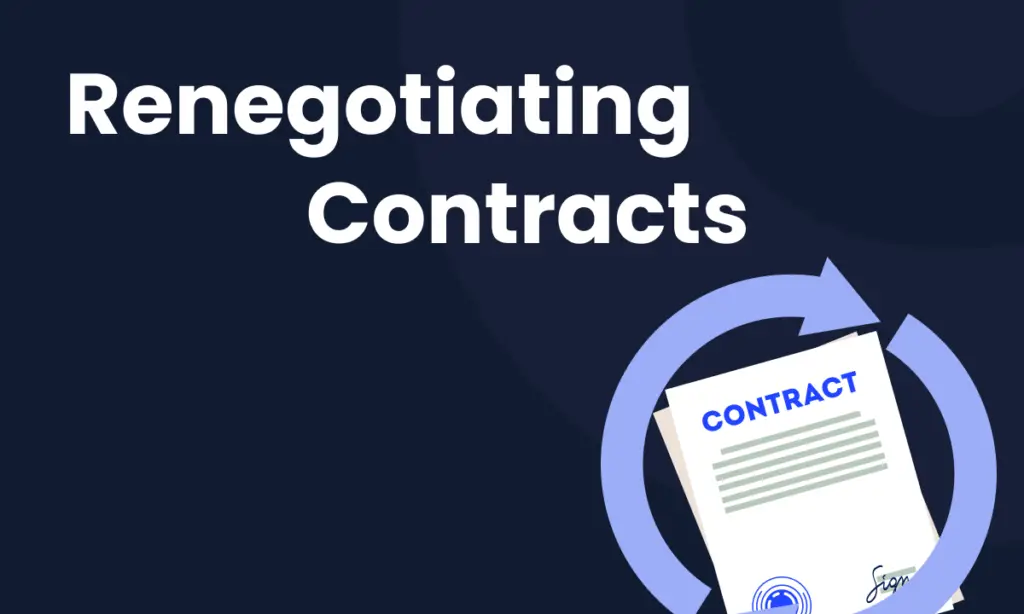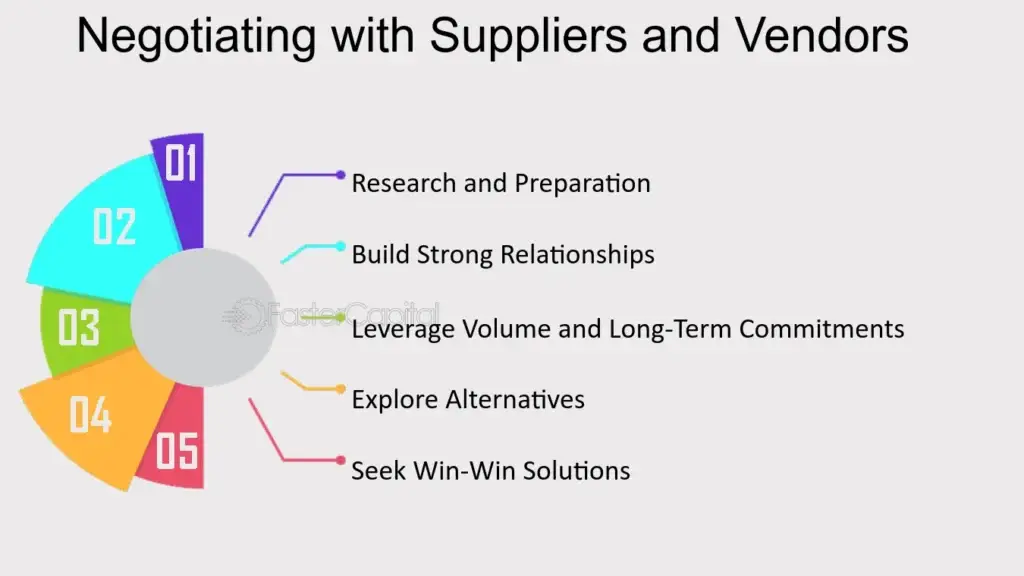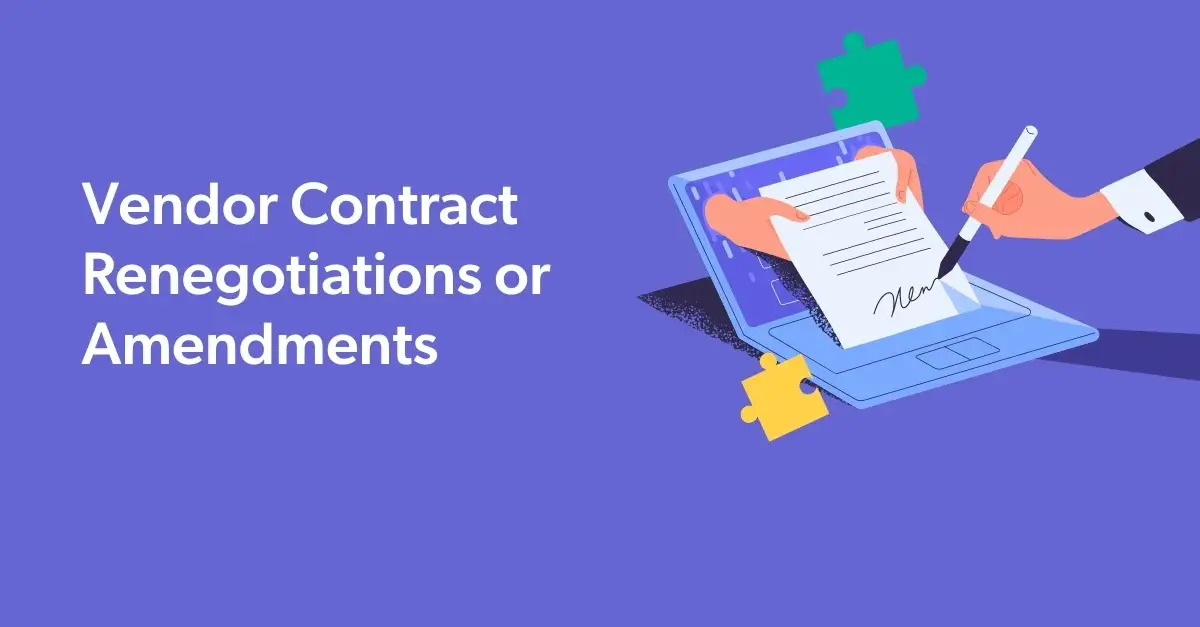In the ever-evolving business landscape, financial volatility and budget variations can arise unexpectedly. These fluctuations often prompt the need to renegotiate contracts with vendors to realign costs and services. A well-thought-out strategy for renegotiation is essential to maintaining vendor relationships while securing terms that support your organization’s financial goals.
Here’s a step-by-step guide on how to renegotiate contracts (How to amend a contract) effectively, ensuring your business stays agile and financially secure.

Table of Contents
Toggle1. Preparation is Key: Analyze and Review Contracts
Before diving into negotiations, thoroughly review your current contracts. Understanding the existing terms, payment obligations, and service levels gives you the foundation for renegotiation. Identify the specific areas where budget variations have impacted your operations and quantify the financial gap.
Tip: Gather market intelligence on current pricing trends, competitor offerings, and available alternative suppliers. This will give you a clear idea of what to ask for and help strengthen your negotiating position.
2. Internal Alignment: Ensure Stakeholder Buy-In
Renegotiating contracts isn’t a one-department task—it requires collaboration from various stakeholders across your organization. Engage teams from finance, procurement, and operations to align on objectives. A united front will ensure you enter the negotiation with a clear set of goals, whether it’s cost reductions, extended payment terms, or improved service levels.
Tip: Set clear negotiation goals that reflect the needs of the entire organization, making sure that any proposed changes benefit long-term financial health.
3. Initiating Vendor Conversations: Build Transparency

Effective communication with your vendors is crucial. Approach them openly about the budget challenges and the need for renegotiation. By emphasizing transparency, you’re not just discussing changes in financial terms but also reinforcing the mutual benefits of a long-term partnership.
Tip: Focus on maintaining a positive vendor relationship. Highlight how renegotiated terms can secure continued business, creating stability for both parties.
4. Crafting a Negotiation Strategy: Be Flexible Yet Firm
When entering negotiations, flexibility is your ally. Propose various solutions such as volume discounts, extended payment terms, or performance-based contracts. Offering flexibility in certain areas can incentivize vendors to accommodate your requests.
Tip: Leverage the market data you’ve gathered. If vendors are hesitant, showing that you’ve explored alternative suppliers or pricing models can create a sense of urgency, pushing them to reconsider their stance.
5. Value-Driven Negotiations: Focus Beyond Just Price
While cost reductions may be a priority, don’t neglect other factors that add value. Look at service level improvements, efficiency gains, or bundled services that vendors may offer to mitigate the impact of reduced pricing.
Tip: Instead of solely focusing on cost, emphasize the importance of maintaining high service standards or improving delivery timelines. This can offset some financial constraints while still maintaining vendor performance.
6. Formalizing Changes: Ensure Clarity and Documentation
Once an agreement has been reached, formalize the changes in a clear, written contract amendment. All modifications should be well-documented to avoid future misunderstandings and legal issues.
Tip: Establish a regular contract review schedule to ensure ongoing alignment with both market conditions and your business needs. This will make future renegotiations more straightforward and help prevent unexpected surprises.
7. Ongoing Management: Monitoring Vendor Performance
Post-renegotiation, it’s crucial to monitor vendor performance continuously. Regularly reviewing service levels and contract adherence ensures that the vendor remains compliant with the new terms.
Tip: Keep communication lines open with your vendors, addressing issues promptly and maintaining the relationship for future collaborations.
Conclusion Renegotiating contracts due to budget variations may seem challenging, but with the right approach, it becomes an opportunity to strengthen vendor relationships and optimize costs. By preparing thoroughly, engaging internal stakeholders, and approaching vendors with transparency and flexibility, your business can navigate financial volatility while securing better terms for the future.
Q&A
How can you renegotiate vendor contracts with both flexibility and decisiveness?
ReNegotiating with flexibility and decisiveness requires balancing your needs with what the vendor can offer. Flexibility means being open to various solutions like adjusting payment terms, delivery schedules, or even service levels. Decisiveness comes from clearly understanding your non-negotiables—such as cost caps, quality expectations, or delivery timelines. Start by identifying areas where you’re willing to compromise and be prepared with alternatives to strengthen your position. At the same time, remain firm on key objectives, ensuring the agreement aligns with your organization’s goals. A collaborative yet clear approach helps in achieving mutually beneficial outcomes.
What role does Vendor Performance Management play during contract renegotiations?
Vendor Performance Management (VPM) plays a critical role during contract renegotiations by providing objective data on how well the vendor has been meeting their contractual obligations. This includes metrics on delivery times, service quality, compliance with terms, and overall reliability. By presenting performance data, you can justify your renegotiation requests, such as seeking discounts or changes in service levels. Strong VPM also allows you to identify areas where the vendor has excelled, which can be leveraged to offer incentives like extended contracts in exchange for price reductions or improved terms.
How to Negotiate with Flexibility and Decisiveness ?
To negotiate with flexibility and decisiveness, balance openness to solutions with clarity on your priorities. Be flexible on non-essential aspects like payment terms or delivery schedules, but remain firm on critical objectives such as cost limits or quality standards. Clearly communicate your needs, listen to the vendor’s position, and be prepared to offer alternatives. This approach ensures a collaborative, yet focused negotiation that benefits both parties.

Jugaad on Two Wheels: The Hilarious Bike Parcel Hack in Karnataka
The Great Karnataka Bike Parcel Hack: A Jugaad Masterclass #RapidoParcel: In a creative yet controversial move, ride-hailing platform Rapido has found a way around Karnataka’s

Denmark’s Digital Sovereignty Revolution: Linux and LibreOffice Lead the Way
Introduction to Denmark’s Bold Move In June 2025, Denmark’s Ministry of Digital Affairs made headlines by embracing digital sovereignty, ditching Microsoft Windows and Office 365

🏏Sports as a Business Strategy: Insights from Vijay Mallya’s RCB Ownership
🧠 Sports as a Business Strategy (Tool) In modern business, few platforms offer better engagement and emotional connection than sports. From football clubs in Europe

🙏 Apologies in Leadership: Vijay Mallya Public Apology
🧠 Introduction: The Role of Apologies in Leadership In the corporate world, apologies aren’t signs of weakness—they’re strategic acts of leadership. When made with sincerity

Audiobook Production Costs: Navigating Recording Artists, Studio Expenses, and AI’s Impact
The audiobook industry is booming, with over 130 million listeners in the U.S. alone in 2021 and a growing global appetite for audio content. Producing

Media Trial of Vijay Mallya: How Public Perception Shaped Vijay Mallya’s Legacy
Introduction: Media’s Influence on Business Narratives In today’s hyper-connected world, media narratives can make or break a business reputation. For Vijay Mallya, once known as

